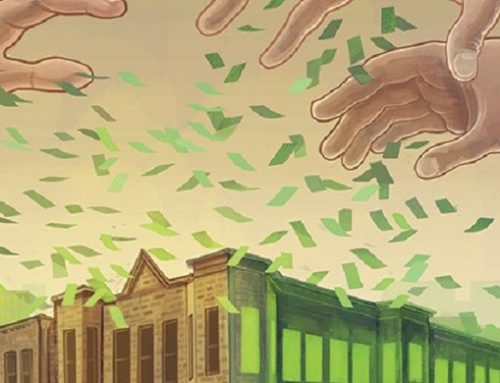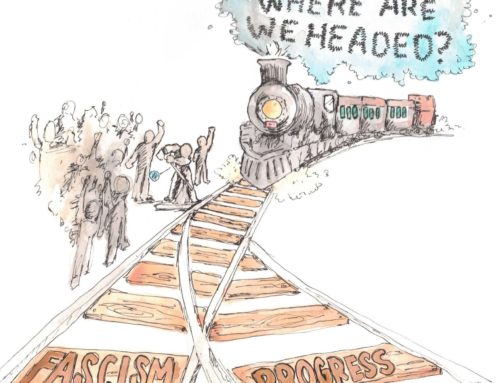By Jan Makandal
In Bangladesh, Haiti, Brazil, China, the U.S. and everywhere, workers are demanding wages that allow them to feed, house, clothe, and educate themselves and their families.
Some on the Left argue that wage struggles are inherently reformist. The reality is that they can be either reformist or democratic (the latter as an embedded element of an overall revolutionary struggle). A thin line divides the two. The difference is that the reformist will be satisfied with reforms and stop there, while an autonomous democratic movement that has the potential to contribute to revolution will keep demanding more and more, continuing to weaken (not mechanically) capital and finally challenge its existence.
This difference results from a political line and strategy. Revolutionary potential exists when there is a dialectical relationship between revolutionary level and democratic mass level organizations. Struggles waged solely at the mass level, without this relationship, will indeed inevitably lead to reformism.
When that relationship does exist, however, wage struggles can weaken capital. This is because capital reproduces itself by extracting surplus value from the exploitation of workers. The struggle for higher wages (forcing capitalists to appropriate less surplus value) can play a crucial role in the development of both a combative working class, and the growth of a mass movement that could ultimately challenge the existence of capital.
Surplus Value
The capitalist mode of production is characterized by the fundamentally antagonistic social relations on which it depends—capital versus labor in the production of surplus value. The production of surplus value differentiates capitalism from all other modes of production (i.e.: feudalism, slavery). Surplus value is the socially determined worth of the labor power that is used to transform natural materials into commodities (goods for exchange), measured in time.
Under capitalism, surplus value is generated in the production process itself, as labor power is incorporated into the process of production, and embodied in the commodity. This is in contrast to feudalist production, which guarantees a surplus by exercising constraint on labor and on consummation exterior to the production process. Under feudalism, peasants toil on the land and the landowners take a guaranteed portion of each harvest, regardless of weather conditions, sometimes leaving the peasant unable to sustain themselves. Under capitalism, workers work a certain amount of time to provide for their own sustenance and reproduction, after which their labor power produces surplus value.
For example, if a worker is paid $80 for eight hours of work, but produces goods worth $80 in only two hours, then the rest of that time, s/he is working without pay. During those other six hours, the worker produces $240 of goods. That amount (minus the other costs of running the industry) is surplus value. The capitalist, who privately owns and controls the means of production, appropriates (steals) the surplus value by asserting ownership over the new commodities. The surplus value is turned into profit when the commodities are sold, and a portion is reinvested as capital for the industry to expand.
This theft of value is exploitation.
A social relationship of domination permits exploitation. The capitalist class dominates the working class in three main ways: 1) economically via their ownership of the means of production (the monopolization of society’s means of subsistence); 2) politically via their state apparatus (including the threat and use of force); and 3) ideologically via their culture (media, religion, education, traditions, etc.). The quantitative forms of surplus value (and profit based on value) are the result, an effect, of these social relations.
These dynamics sustain and enrich the capitalists who do not work, while workers struggle to reproduce themselves. The stolen labor-power of the workers is used to fund militaries, hospitals, universities, and everything else which ensures and reproduces capitalism’s existence. Surplus value is class struggle in the process of capitalist production, the struggle of the capitalists to constantly dominate the workers in order to exploit them.
It is important that we understand surplus value as a social process. It is not simply an economic phenomenon, which could be resolved within the capitalist framework. It is fundamental to (and allows for the reproduction of) capitalist relations economically, socially, and politically.
Wage struggles demand the return of what is stolen from the workers. Wage struggles are important because they strike at the very core of capitalism—surplus value—and its external manifestation of exploitation. The wage struggle is the fundamental aspect of anti-capitalist struggle. This is why it is important to struggle around wages. And during the period of global monopoly capitalism/imperialism (and imperialism’s concrete political form of neoliberalism), it is crucial for the working class to unify internationally against its common enemy. This can be accomplished by organizing and struggling for an international minimum (living) wage.
Organizing Wage Struggles
Wage struggles tackle the fundamental contradiction of capitalism: capital vs. labor. They help build the militancy of the working class and help train them to take power. Wage struggles seek wage reforms with the goal of abolishing wages altogether. The abolishment of wages is ultimately a political struggle, which requires the role of proletarian revolutionaries to organize revolution.
There are two levels of organization: a revolutionary level and a democratic mass level. Both need to function in relative autonomy, but in a dialectical manner. The revolutionary level constructs political rapprochement with the mass level with a goal of struggling among the masses, while being aware of and avoiding capitalist attempts to divert organizing efforts into dead ends. Political rapprochement is a constant back-and-forth dialectical dynamic between the two levels, for the purpose of constructing unity and strategy.
The revolutionary level must engage in both kinds of struggles: for reforms (not reformism) and for revolution. We must be serious in theory and in practice, and must construct mass organizations among workers and social categories (such as students). Theory must be dialectically connected to practice; it should allow us to develop a line to engage in practice, so we know what we are doing. We need to have a clear understanding of the contradictions we face, which will make us better organized and more capable of tackling our well-organized enemy: capital.
It is crucial that we understand the dynamics of our enemy. In a struggle for wages, we must be aware of and combat reformism and economism, which result in the integration into the capitalist system. For example, the civil rights and the feminist movements were able to be absorbed into bourgeois democracy, because their main focus was on economic integration, “equality” within the marketplace, rather than on the question of fundamental political power. One class did not overthrow another to transform society on a totally new basis; instead the same capitalist class remained in power, while slightly broadening its ranks, and expanding bourgeois democratic rights, for the reproduction of capital.
It is the task of proletarian revolutionaries to apply the correct line inside the mass level to avoid these types of deviations.
In Haiti, we are waging two levels of struggle. One is a minimum wage adjustment (for inflation), and the other is a struggle for an increased minimum wage. Both are important struggles to organize workers. These struggles are totally against neoliberalism, which actually calls for no standard on wages—a point defended by most presidents in Haiti (who operate the state apparatus in the interest of the dominant classes and imperialism). These struggles are not reformist, because we engaged in them, principally, with the goal of the abolition of wages. But we understand that socialism won’t fall from the sky. We need to be strategic. We must understand, and then use, the reality in front of us in order to engage to transform that reality.
Before we can kill capitalism, we have to weaken it and simultaneously strengthen our side. We can only do this if we tactically apply a correct revolutionary strategy, a correct political line. All social classes historically struggle to either reproduce themselves or to transform the reality they are in.
Members of the petit bourgeoisie, for example, go to school to learn a skill to guarantee their reproduction. If they want a higher paycheck, they go back to school to serve capital at a higher level, and aspire to become a bourgeois. This is the dominant historical ideological tendency of that class. The fundamental component of that tendency is individualism.
In contrast, the dominant tendency of the working class for its reproduction is struggle. The higher form of that struggle is the strike at the mass level, which workers can only do collectively. The dominant historical ideological component of the working class is collectivism, the antithesis of individualism (which ideologically corresponds to private property).
The Dead-End Path of Left Populism
Global capitalism is attacking every social category among the popular masses (every social and cultural group). This has given rise to a diverse, multi-faceted resistance, seeking to challenge capitalist domination. But though these movements are sometimes combative and significant, they are not based on a class alternative. They are therefore an amorphous amalgam, prone to confusion. Without a class orientation and a corresponding political line, these movements are unable to define clear lines of action aimed at real emancipation. They are unable to go beyond a ‘broad-based, popular’ desire for equality, and are therefore subject to populist drift. This characterizes the radicalized petit bourgeoisie’s response to the adverse situation it finds itself in.
The radical petit bourgeoisie spontaneously gravitates toward an ultra-leftist orientation of egalitarianism, which has its underlying foundation in the struggle for economic equality in the marketplace (for their own reproduction as a class). This leads to a mechanical materialist (actually idealist) and economist approach of rejecting unilaterally the economic struggle of the proletariat (a fundamental aspect of the fight against capital for its reproduction). This has fostered a dangerous tendency to develop in popular struggle: left populism that will quickly transition to right populism.
This tendency results in the displacement of the struggle against the fundamental aspect of capital (the processes of exploitation of labor power and production of surplus value), to focus instead on secondary aspects (which are produced by the fundamental aspect). The consequence is that all struggles waged against these secondary aspects or effects of capitalism (which are also the effects of any prior class society based on private property)—racism, misogyny, and other forms of oppression and inequalities, plus ecocide—become viewed as anti-capitalist struggles.
These secondary aspects have currently become the center pole of mass struggles. They are indeed worth fighting against—capitalism affects society and the environment in many terrible ways that no one should accept. But as justified as these struggles are, they are not materially (concretely) anti-capitalist. They are progressive, but limited, because even with a very high level of radicalism, they cannot stop capitalism. History has already proven to us that they can be recouped by the capitalist class. If these struggles are waged outside of, and disconnected from, a genuine anti-capitalist struggle targeting the fundamental production of surplus value, then the danger is that they can be transitioned into to an enlargement of bourgeois democratic rights, or false “solutions” to problems like ecocide, unintentionally serving the interest of the reproduction of capital.
Revolution is the overthrow of one class by another
There is only one reality with many alternatives, all detectable and determined by class struggle in our time. We must recognize the fact that the dominant “alternatives” being currently offered are reformist ones. The job of proletarian revolutionaries is to define what must be done to reverse, in our favor, the struggle for alternatives, in order to deal with—and eliminate—the two fundamental aspects of capital: exploitation of labor power and the process of production of surplus value.
The abolition of wages is, in principle, the collective appropriation of the means of production by the proletariat. To ignore wage struggles is to deny and avoid the immediate economic struggles of the workers, which are one level of class struggle (others are ideological and political). The working class should not abandon its daily struggle against capital, but should continuously advance it for the objective of its collective appropriation of the means of production.
The abolition of wages will inevitably lead to the abolition of classes. However, a necessary precondition for this is revolution. Through liberating itself, the working class liberates all of society from capitalism.
The choices to be made in this epic effort to crush capitalism are not simple or mechanical; they are to be found only in the complex reality of class struggle. At the mass democratic level, the fight for wages is one form of struggle for the objective of weakening the system, but it is never a final goal. Our aim is the elimination of classes once and for all.
We should never be satisfied!






A noble aim (elimination of classes), how does one begin? There are the 400 richest capitalists that control more wealth than the rest of us combined, the elimination of that sector is one way to begin. Fear of that not understood (comprehended) is a beginning, one needs to strike that fear into the capitalist heart (and mindset).
Solidarity.
[…] Wage Struggles: Reformist or Revolutionary? (onestruggle.net) […]
[…] Wage Struggles: Reformist or Revolutionary? (onestruggle.net) […]